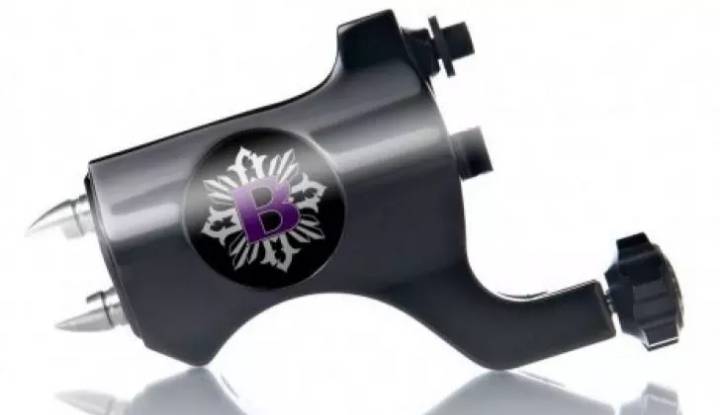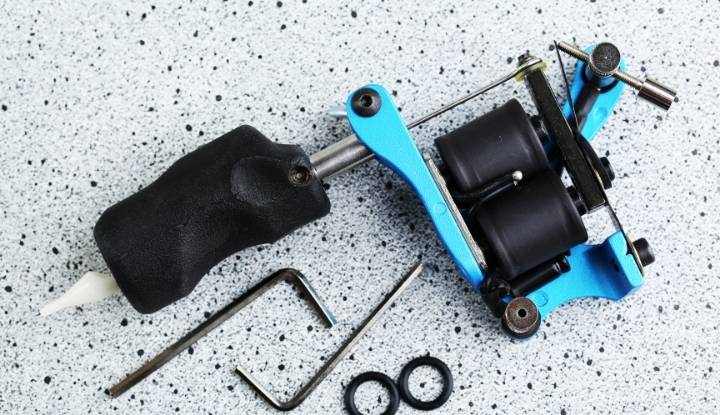Nowadays, many individuals are passionate about getting a tattoo pierced in different parts of their body, and some of them cover up every inch of their body with various tattoos.
We choose images based on our likes, perceptions, and thoughts. So, it isn’t surprising that many individuals have now taken up tattoo piercing as a business venture.
How do they do it? Simple, using a tattoo machine to get yourself the colorful and mysterious images of your choicest figurines.
Table of Contents
What Is a Tattoo Machine?
Many of us have mistaken the tattoo machine for a simple pen or gun, given its shape and size.
But, on looking closely, you realize that the tattoo machine is a small device that helps you create a permanent marking (tattoo) on your skin. The device is held in your hand, and the ink is used to draw or write a permanent marking on the skin.
How Does the Tattoo Machine Work?

The device looks extremely simple, but before using the machine, it helps you get a better perspective when you clearly understand its parts and working.
Call it a tattoo machine or a tattoo gun as the machine is shaped likewise too, the device consists of metal parts that include a vise, a screw, handle, holder, needle holder, and a conductive pair of coils and springs.
Along with the help of an AC capacitor, the coil helps generate a current, meaning that we need electricity to operate the tattoo machine.
An AC is generated using electromagnetic coils. The current is set such that it goes to the capacitor that exists as the driving factor behind the functioning of the machine’s springs.
It is via the springs placed on the base frame that the needle gets the necessary power to pierce the skin.
The tattoo machine’s backside has the contact screw, and it is here that you can stop the razor using your hand. The front part of the machine that holds the needle also has a tubular metal handle connected to the metal frame using a vice.
Remember, all machines are not constructed the same way–the size of the needle and the handle directly depends on the size, design, and type of tattoo preferred by you.
Types of Tattoo Machines
It is a taxing job to decide upon your favorite image that you wish to pierce on the skin as this would remain permanently with you forever.
If you don’t have any prior idea about tattoos, it shouldn’t be surprising that you would be quite unaware of the types of tattoo machines available for use.
Gone are the times when we used manual power to poke the skin of the individual. Now, we have the most advanced machines that use the best technology to create fascinating works of art on the skin.
To understand how some tattoos are intricate while others are not, it is ideal to understand different tattoo machines’ functioning.
The most common types of tattoo machines used in the market include:
- Rotary tattoo machines
- Coil tattoo machines
- Pneumatic Tattoo Machine
Rotary and coil tattoo machines find widespread use among individuals. Any artist is an innovator, and it is generally observed that they use pieces from one machine and fix it on to another one to bring about better productivity in their work.
Still, the basic working of any machine remains constant.
Let’s take a closer look into each of these machine types individually.
Rotary Tattoo Machines

Original is always the best, and the Rotary tattoo machine introduced in the year 1978 by Manfred Kohrs takes pride in being the first one available in the market.
The machine’s functioning that uses an electric motor to operate the needle brought a new perspective to tattooing, enhancing the image’s detailing and finer aspects.
A DC motor that’s present inside a strong outer cover helps move the needles to the desired position (up and down). Though the machine’s operation is trivial, it remains one of the most widely used ones for tattoo piercing.
It depends on the tattoo artist to develop his/her creativity and innovations that could be applied to these machines.
With such add-ons, the rotary machines function better and efficiently, helping the artist develop mind-blowing designs and artistic skills.
Some of the popular features of a rotary tattoo machine that makes it still a sought-after one in the market are:
- Lightweight nature helps the artist hold the machine easily for long hours without much pain.
- Simple handling promotes better use by individuals more frequently.
- Minimum finger cramps
- Reduced needs of adjusting the machine that saves much time and helps you focus more on the art
- Popularity among popular tattoo artists
- A comparatively lower noise generation
- The possibility to use a single machine for both lining and shading
Coil Tattoo Machines

Many of us have heard the buzzing sound coming out of a tattoo shop in our neighborhood. To clear your doubts, it is nothing but the coil tattoo machines at work in the hands of a talented tattoo artist.
The noise could indeed be quite loud to others, but for the tattoo artist, it helps him/her silence all external disturbing factors and focuses solely on the tattoo piercing job.
A coil tattoo machine might have found fame for its noise levels and curious spectators outside the shop, but, truthfully, this machine attained popularity for its versatility and excellent working abilities.
A coil tattoo machine could be delineated into three categories, such as liners, shaders, and color packers, in contrast to a rotary machine where the lining and shading jobs are on the same. As the name suggests, each of them has its segregated workings.
A tattoo comes out beautifully only when the outline is perfect and the image is clear. A liner does exactly this—it helps create fine and precise outlines—it could be a tattoo outline or anything inside it. Also, the liner works faster than a shader or a color packer but doesn’t go as deep as the other two.
Shaders help in filling different colors and are useful for bringing the touch of different gradients. Their longer armature bar can go deeper and harder than liners that help you get an authentic coloring and a deeper impression on the skin.
Again, a color packer machine functions similarly to a shader as these are also used to fill the image with colors or blacks.
A color packer helps you bring the deepest shading on the skin, even better than a shader, but they don’t gel well with grey scales of gradients. If you wish to pack your image with colors that plunge deep and hard, don’t forget to use the color picker.
Generally, coil machines are available as dual-coiled ones consisting of eight to ten wraps. Using the coils, the artists create resistance and inject ink on the design with control and ease.
As the name suggests, you can ‘pack’ colors and pigments in a single go without having to rework your artwork repeatedly.
Some of the best benefits of using a coil tattoo machine are:
- The ability to complete the tattoo-piercing process quicker
- Easy regulation of speed and power
- The heaviness of the model lets you take better control of it.
- A superb fit for customizing and interchanging parts
- One of the most popular tattoo machines available in the industry
Pneumatic Tattoo Machine

The pneumatic tattoo machine designed in the year 2000 revolutionized the tattoo marker and thrived as the most popular one, only next to the rotary and coil tattoo machines.
A pneumatic tattoo machine uses an air compressor to power the needles in contrast to rotary and coil machines.
The speed at which the needles move up or down depends on the air pressure adjustment. Air compressors could be gas- or electricity-operated, and whichever you choose, you must make an additional investment in buying them.
The primary difference among these predominantly depends on how the needle injects ink on the skin and how it is powered in its upward and downward movements.
There are multiple benefits and disadvantages attached to this tattoo machine that makes us contemplate using it. Some of the advantages of using a pneumatic tattoo machine are:
- Lightweight and compact that makes it easier for the artist to hold onto the machine for a longer period, thereby helping him/her create complex tattoos
- The machine is compatible with different sized needles and tubes. The artist needn’t hunt for the ideal match but use any of the good supplies. You can make use of round and flat needles when focusing on both lining and shading.
- The benefit of using the same machine for lining and shading works rather than spending money on buying two different ones.
- The ease of use is a strong motivating factor for many artists.
- Simple and better cleaning and sterilization where the entire machine needn’t be disassembled
- The pneumatic tattoo machine seems to be the best fit for use at different events or functions. It could be operated either using a gas or air compressor without the need for electricity.
At the same time, there are numerous downsides attached with the pneumonic rotary machine:
- A deafening noise that disturbs the people around
- Using the machine means that you must set up an air compressor for using it, which seems bulkier.
- More expensive than a coil or rotary machine. Also, the need to buy an air compressor increases the total costs even higher.
- Unlike a rotary or coil machine, a pneumatic tattoo machine isn’t easily available online or in the supply stores. The good thing is that once you procure them for use, getting the needles and tubes is easier as the machine is compatible with most.
- Not quite suitable for mobile tattoo shops as the machine is bulky, and moving it frequently is quite hard.
You might be a great artist, but you need to get hold of the right equipment to portray your abilities. Like how a paintbrush supports a painter to paint and color, choosing the right tattoo machine is essential to express your creativity and potential.
Pick the right machine that fits your art style and start unleashing your skills without boundaries.